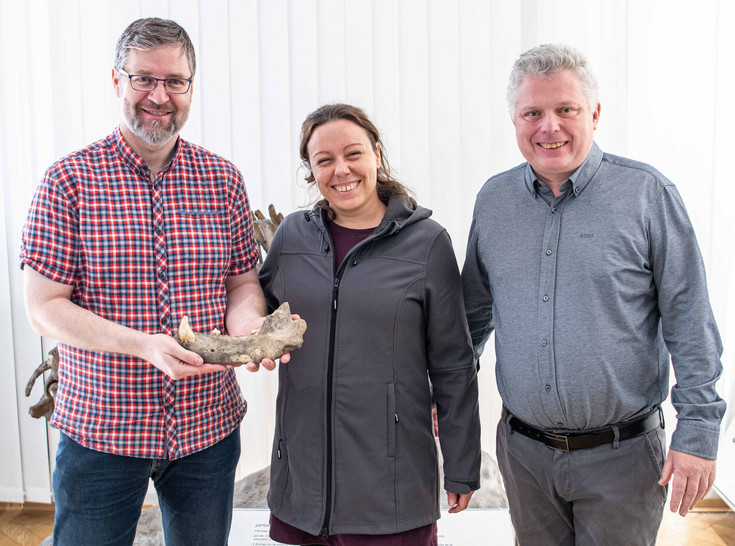15.07.2024 - A cave bear returns

While working on the natural history collection of the Cistercian Dominik Bilimek (1813-1884) at BOKU University in Vienna, a contemporary witness of an early cave bear excavation in the Kreuzberg cave in Slovenia was discovered. This find, already documented in the historical literature, has now been returned to the Narodni muzej in Ljubljana (Natural History Museum of Slovenia) after 178 years.
The Bilimek Historical Collection is home to many historical artefacts. In the 19th century, the Cistercian priest Dominik Bilimek was a scholar in many disciplines such as zoology, botany, geology and mineralogy, and was also an enthusiastic collector. His collection of minerals, rocks and fossils was donated by Heiligenkreuz Abbey to the Institute of Applied Geology (IAG) at BOKU ten years ago. The team at the Institute has been working intensively for several years on the history of the scientific and historical collection and its conservation. A special fossil from this collection is the lower jaw of a cave bear from Križna jama (Cross Mountain Cave) in Slovenia. It lived several tens of thousands of years ago during the last Ice Age and chose the cave as its sleeping place, where it hibernated every year.
On 7 September 1846, during Bilimek's journey through Slovenia, the first known excavation of a cave bear took place in Križna jama - 30 years before Ferdinand von Hochstetter's excavations for today's Natural History Museum in Vienna. Bilimek donated these finds, a box of cave bear bones, to the Ljubljana Museum, which was documented in the Illyrian Gazette (1847). From this collection, Bilimek kept only a single lower jaw as a souvenir. As the box containing the bones is no longer preserved, the jaw is the last witness to this early cave bear excavation and has now been handed over to the Natural History Museum in Ljubljana by the Institute of Applied Geology after 178 years.
Christian Zangerl, head of the Institute of Applied Geology, emphasises the scientific and historical significance of the find: The lower jaw of the cave bear is an important witness of the early excavation work, which can now be returned to its homeland thanks to the detailed compilation of sources such as find notes, diary entries and historical press reports. Križna jama has already been visited by staff from the Institute of Applied Geology at BOKU University in April 2023. Other projects related to the Bilimek Collection are currently being planned.
Publications on the Bilimek Collection at the University of Natural Resources and Applied Life Sciences, Vienna
Lukeneder, P., Liebhart, I., Ottner, F., Mikes, A., Heinz, P., Polách, R. The Historical Power of the Natural History Collection of Dominik Bilimek at the University of Natural Resources and Applied Life Sciences, Vienna (BOKU). doi.org/10.1098/rsnr.2022.0051
Hopfensperger, B., Maletz, J., Lukeneder, P., Heinz, P., Ottner, F. Early graptolite research: Eduard Suess and the Bilimek Collection. doi.org/10.3140/bull.geosci.1829
Scientific contact:
Dr Christian Zangerl
Head of the Department of Applied Geology
BOKU University
+43 1 47654 87211
christian.j.zangerl@boku.ac.at
Dr Franz Ottner
Institute of Applied Geology
Phone +43 1 47654 87214
franz.ottner@boku.ac.at
Petra Lukeneder, M.Sc.
Institute of Applied Geology
petra.lukeneder@gmx.at
